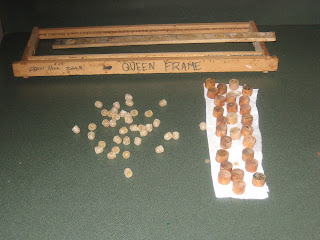

This afternoon I put my Cloake Board (CB) onto a good, strong colony of bees. The CB allows you to transform a colony of bees that are queenright (with a queen) into a colony that's queenless simply by sliding in a metal tray.
Once you determine that you have a suitable colony for raising queens you take off a box containing some capped/uncapped brood and shake all the bees off back into the colony. You place the CB onto the colony and put the box with the now empty frames back onto the colony. Then you rotate the colony 180 degrees so that the bottom entrance now faces what used to be the rear of the colony. The entrance to the CB faces in the same direction as the original colony's entrance. A CB has a queen excluder-sized grill for its floor. The nurse bees that were shaken off of the frames of brood are irresistably drawn back to the frames of brood that are now above the CB. What you are trying to do is to get a large amount of nurse bees above the CB that will draw out queen cells when the metal tray is slid into place. The bees above the CB think they are queenless and readily draw queen cells. Once the process of drawing cells has started you return them to a queenright state to finish the cells.
It helps to have a feeder on the colony to provide a source of carbohydrates for the bees that need to draw wax for the cells. Reversing the entrance makes the field bees reorient to the 'new' top entrance above the CB. The bees put their abdomen into the air, bending the last segment of their body to expose the Nasanov gland, and begin fanning their wings. In 24 hours we'll put the slide in to separate the bees above the CB from those below and to make them think they're queenless. In a day or so we'll graft larvae into queen cups and put them into the box above the CB. If we do everything properly we should find the bees drawing queen cells within 24 hours of our graft. Stay tuned.
Mike






















